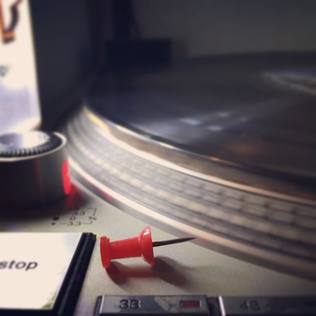But there’s no telling how well those records were taken care of. That same copy of Easter had scratches all over the title track, causing maybe a dozen skips.
There’s nothing I can do but toss it back in the garbage, right?
Wrong.
With some patience, steady hands, and nerves of steel, I was able to get the record to play through without skipping. I’ve been able to do the same with a few other records too, including the copy of Wish You Were Here that I carelessly dragged the needle over once and a trashed copy of My Bloody Valentine’s Loveless that I got for cheap.
And now, I’m going to pass on that knowledge.
But before we go on: this is a last resort. Do not attempt this on any record that isn’t otherwise unlistenable.
To understand how to fix skipping records, we have to understand what causes these skips.
Vinyl is a physical medium. The music is physically in the grooves. As the needle drags through the grooves, it translates the physical shape of the grooves into soundwaves.
Vinyl is also soft. When a record is scratched, the vinyl in the upper portion of the groove is pushed into the path of the needle. When the needle hits this displaced vinyl, it’s kicked out of the groove and lands in an earlier portion of the song. The needle travels the groove until it hits the scratch again, and it kicks out again.
Forever.
But if you’re feeling brave, you can clear the groove and give the needle a clear path, getting rid of those pesky skips.
Play your record and listen carefully. When the needle skips, stop the record and look carefully.
Manually push the record through the skipping portion. Look carefully to see exactly where on the disk the skip is happening.
Run your finger over the source of the skip. If you can feel a bump, try light scratching it with your fingernail in the direction of the grooves. Start the turntable again. If the skipping persists, it’s time to get a little more serious.
Push the record over the skipping section again. Try to keep your eye on the exact groove the needle is passing through. You will probably see a scratch or a speck on the record. If it’s a particularly deep scratch, it might be grabbing dust off of the needle as it skips. Look for any spots on the scratch where dust is collecting.
Take your pin and rest it near the obstruction. Be very careful to not push down very hard, or you might make more problems for yourself. Keep a steady hand to avoid adding more scratches
Apply some light pressure to the pin and work it back and forth through the groove at the scratch or contamination. As you push the pin along the groove, you should feel a little bit of resistance from the problem area. Take care not to bump the needle.
Start the turntable again and watch. If you found the right spot, it should play through with a mild pop or static. If this happens, stop the turntable and manually move it back and forth over the scratch, like a really boring DJ. If it keeps skipping, try hopping to either of the adjacent grooves.
Keep note that this method only works with looping skips—that is, when the record skips to a previous portion of the song. If the record jumps forward, that’s because the divider between the grooves has been worn away, making the two grooves one. As far as I know, you can’t fix that.
But you know what’s even easier than fixing scratches with a pin? Avoiding them altogether. Here are some tips to avoiding scratches.
- If your turntable has a cue lever, use that to lower the needle
- Avoid bumping the needle while the record is playing (or at all)
- Take care when inserting records back into inner sleeves—watch out for dust in the sleeves
- Be careful when flipping the record and placing it on the spindle
- Don’t pack records too tightly. This presses dust into the grooves
If you’re feeling bold—or if you have a worthless record to practice on—give this a shot. I’d love to hear if anybody else is able to make it work.
